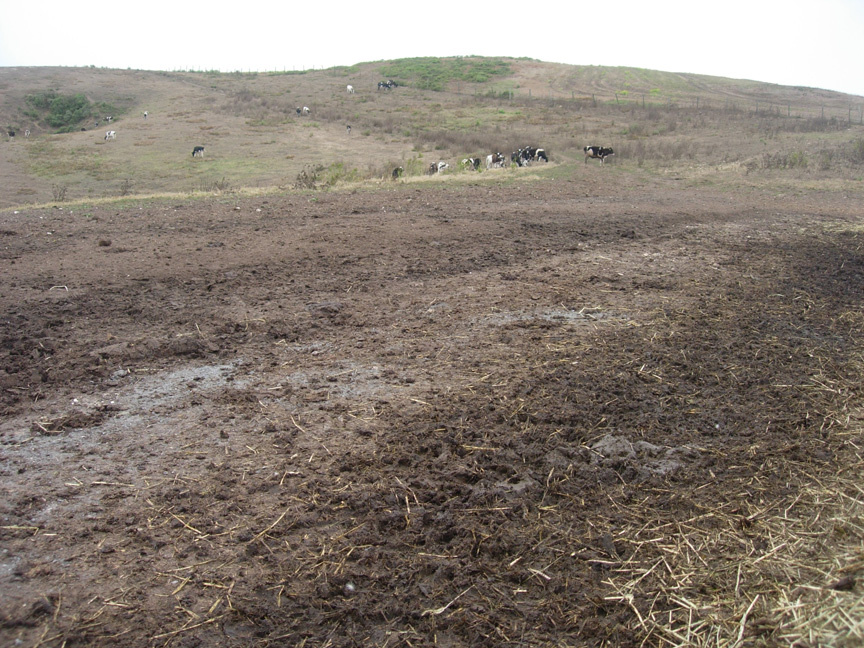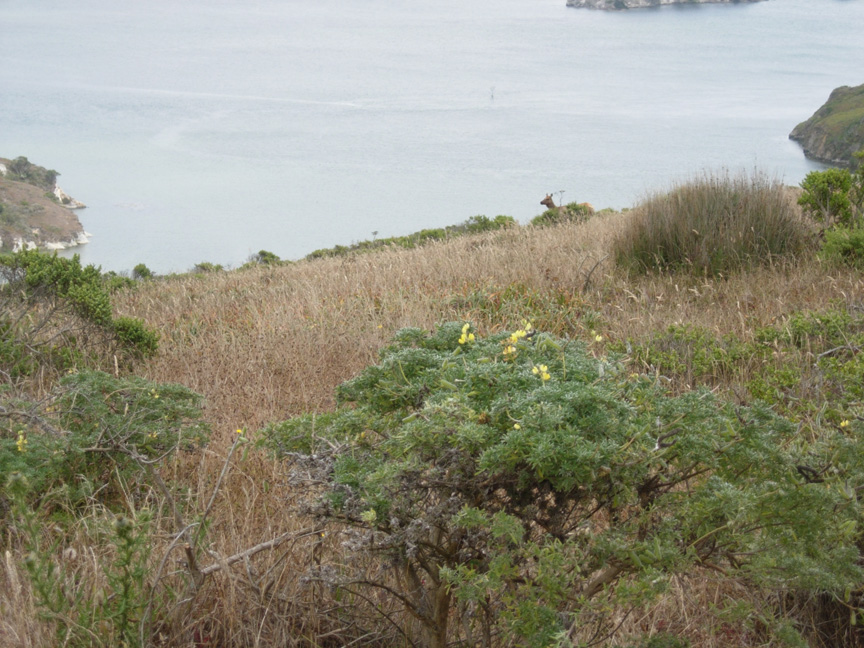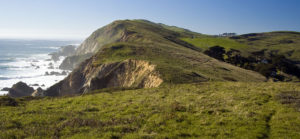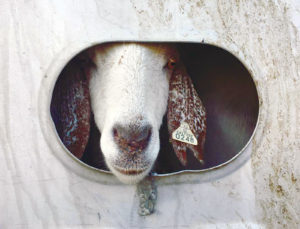Should cattle grazing be allowed on our public lands in the Bay Area? From a conservation viewpoint, cattle grazing is simply incompatible with maintaining and restoring wildlife, native plants and natural resources.


Making sound decisions on how to best manage our public lands depends on understanding their ecology and using good science, factors that seem to be missing from much of the advocacy for public lands grazing. Too many articles on grazing, including a recent one in Bay Nature (“Range of Possibilities”) uncritically repeat misinformation, myths, and unsubstantiated claims about the benefits of livestock grazing and the supposed catastrophic consequences of removing cattle from Bay Area parks and open space.
The article paints damaging overgrazing as an artifact of the past. Yet most of the damage wrought by livestock — such as degradation of stream function, riparian habitat and biodiversity — is ongoing. The science is conclusive on this damage. Too many native ecosystems in our public parks and watershed lands continue to be degraded by cattle. And many studies document how removing cattle can restore trout populations, native songbirds, wildflowers and amphibians.
Let’s get one talking point for public lands grazing out of the way — keeping ranchers in business to protect valuable open space from development. That argument is not relevant for publicly owned lands that are under no threat of development.
Bay Area habitats have been evolving for the great majority of the last 10,000 years without heavy grazers like cattle. Advocates of so-called “Holistic Resource Management” characterize cattle as merely replacing large native herbivores from the Pleistocene, but this rationalization has been thoroughly debunked by leading ecologists, botanists and evolutionary biologists. Cattle are an extremely recent ecological phenomenon in the Bay Area, and are a particularly destructive invasive species.


Although some landscapes and habitats in the Bay Area benefit from disturbed soil conditions, which were once provided by native ungulates such as elk and by wildfires, cattle do not mimic those conditions. Cows use the landscape very differently than native browsers like elk or deer.
Yes, there is some evidence that carefully managed cattle grazing can improve habitat for some species in some places — such as threatened California red-legged frogs and California tiger salamanders in stock ponds. However, neither of these native amphibians evolved in stock ponds. There is more evidence that cattle damage the vernal pools that tiger salamanders need for natural breeding habitat and devastate stream habitats for red-legged and other native frogs.
In California, cattle were responsible for replacing native bunchgrasses and carpets of native wildflowers with the invasive annual weeds, such as wild oats and cheatgrass that now characterize Bay Area grasslands. According to the California Native Plant Society, livestock grazing negatively impacts more acres of wild native plant communities in California than any other activity. There are dozens of local native plants that are jeopardized by cattle grazing and at least 21 of our endangered and threatened wildlife species in the Bay Area are harmed by cattle grazing.
Hundreds of scientific, peer-reviewed research papers detail detrimental environmental impacts from livestock grazing in the western U.S.. Study after study chronicles cattle damage to soils, waterways and wetlands, native plants, wildlife habitat, oak regeneration and ecosystem function. Symmetrically, there are numerous examples of overwhelmingly positive ecological benefits from excluding cattle from western landscapes, especially from stream and riparian habitats where cattle do the most damage.
You don’t need to be a scientist to understand the damage caused by cattle. Any visitor to Bay Area parklands with cattle can compare grazed grasslands with areas inaccessible to cattle, such as between rock outcroppings and on steep slopes, and deduce which areas exhibit more native plant diversity and provide more habitat structure and cover for native species.
The science documenting negative impacts from cattle grazing is published in peer-reviewed ecological journals. Contrast these with the rash of pro-grazing “studies by ranch scientists” cited in “Range of Possibilities” — referring largely to articles in livestock industry publications or materials produced by grazing advocates without scientific review. Dubious claims about supposed benefits from cattle grazing such as increasing native perennial grasses, effectively controlling weeds, and providing fantastic rates of carbon sequestration are unlikely to stand up to scientific scrutiny.


Studies asserting solely positive impacts from cattle grazing often do not disclose that the required grazing regimes would need an unrealistic level of intensive management that is neither economic for the livestock industry nor achievable for public land management agencies. “Well-managed” grazing presupposes lease-holders who prioritize the public interest and good ecosystem management over profits. While a commercial leaseholder may have the best intentions, ranchers take public lands grazing leases because of the significant subsidy compared to private lands.
Public agencies simply do not have the staff or funding to properly monitor grazing operations, let alone reduce cattle damage or intensively rotate and manage cattle for beneficial impacts. The best-intentioned grazing management plans are often not carried out due to lack of monitoring, personnel, or funding, and can be abandoned or altered when committed and experienced project managers leave an agency. Meanwhile, our public lands suffer from soil erosion, impaired water quality, invasive weeds and damaged streams.
Looking at management of large public lands grazing programs in the Bay Area does not inspire much confidence. The East Bay Regional Park District (with grazing leases on more than 57,000 acres) routinely approves land use plans for its parks which prioritize commercial cattle grazing, with no substantive environmental review or evaluation of negative grazing impacts. In the parks where the public and conservation groups have documented damage from cattle and tried to reduce grazing or suggest alternative management (such as in Sunol, Ohlone and Sycamore Valley parks), the Park District has ignored the input.
The Park District convened a “Grazing Review Task Force” from 2000 to 2001, tasking a panel with a blatantly pro-ranching bias while validating the district’s grazing program. The process deliberately excluded ecologists, scientists and other land management agencies critical of cattle grazing. There was no pretense of scientific study by any experts or the park district for this review. A similar approach has been the norm for grazing programs of the SFPUC (33,000 grazed acres) and EBMUD (grazing 21,000 acres).
The situation at Point Reyes National Seashore is a microcosm of what’s wrong with grazing cattle on public lands. Ranchers who enjoy heavily subsidized grazing leases within the park are lobbying the Park Service to remove, kill, sterilize or fence out the native tule elk. In the only national park with tule elk, where one quarter of the park is devoted to commercial cattle operations, a handful of ranchers are attempting to dictate Park Service policy that removes elk and harms other park wildlife. The Park Service allows some of these same ranchers to chronically violate their lease conditions by stocking excess cattle, allowing cattle to trespass out of the pastoral zone to eat forage needed by wildlife, and raising animals not allowed in their leases. Even in the wake of the deaths of more than 250 elk at Point Reyes due to fencing restricting their access to water and food, the ranchers are pushing for greater limits on elk. One of the claims by the ranchers is that native tule elk, which were nearly wiped out in California before being reintroduced to places like Point Reyes, should somehow be removed as an “invasive” species,” leaving the park’s grasslands for cattle.
There are some encouraging examples of restoration of public lands with the removal of cattle. The SFPUC has committed to fencing cattle out of the entirety of the upper Alameda Creek corridor to help restore steelhead trout and protect habitat for native frogs. The GGNRA has ongoing projects to fence cattle out of tributaries to Lagunitas Creek to protect coho salmon. EBMUD documented the restoration of the riparian corridor and dramatic recovery of red-legged frog and steelhead trout populations in Pinole Creek after removing cattle for only a few years. When cattle are removed from public lands, native herbivores can begin to restore native habitat. Since cattle were removed and tule elk were restored to Tomales Point at Point Reyes in 1979, the Park Service has documented recovery of native plants on the peninsula.

A good test case for removal of cattle from public lands occurred at Mount Diablo State Park. As early as 1979, the California Department of Parks and Recreation (CDPR) identified cattle grazing as harmful to the ecology of Mt. Diablo. For a decade, the CDPR thoroughly examined the negative environmental impacts of cattle, and eliminated commercial grazing from the park in 1989. Livestock operators fought the removal, claiming that cattle were needed to maintain biological diversity and manage for wildfire. The CDPR found just the opposite, concluding that livestock grazing led to an increase in weedy annual species, while cessation of grazing decreased weedy species and increased native grassland species. The CDPR also found no difference in fuel loads in grazed and ungrazed areas on Diablo.
There is no evidence that removing cattle contributed to the Diablo wildfire in 2013. The mountain ecosystem is in fact largely dependent upon fire. A recent Bay Nature article “Mount Diablo After the Fire” examined how beneficial the Morgan Fire was for the Diablo ecosystem. No cattle grazing has been needed to maintain this public lands gem for the past quarter century. Today, cattle-free Mt. Diablo State Park is unquestionably one of the best native wildflower habitats in the Bay Area and the cattle-free park also supports 16 rare or endangered wildlife species.
A discussion of cattle grazing impacts on public lands should also include: the toll of predators and other wildlife killed for the benefit of ranchers; harm to wildlife from cattle fences; excessive water use for beef and dairy operations; reduced forage for native wildlife; public safety issues with documented attacks by cows on hikers; cattle contributions to climate change through greenhouse gas emissions; and human health risks due to livestock passing potentially deadly parasites into drinking water sources.
As we enter a fourth year of drought and increase our knowledge of how human impacts continue to degrade Bay Area ecosystems, our public park lands and open spaces are increasingly critical refuges for native plants, wildlife and biodiversity. On publicly owned lands that are under no threat of development, protection and restoration of the natural environment should take precedence over cattle grazing that harms the environment.
Karen Klitz lives in the Bay Area, is on the Board of Directors of the Western Watersheds Project, and has been working for protection of public lands and on grazing issues for 20 years.
Jeff Miller is a conservation advocate with the Center for Biological Diversity and is director of the Alameda Creek Alliance. Jeff has been working on public lands grazing issues in the Bay Area since 1997.
Stay tuned for tomorrow’s “Pro” argument from Sheila Barry, a natural resource and livestock advisor for the University of California Cooperative Extension, on why grazing on public lands makes sense.
References:
Abdel-Magid, A. H., G. E. Schuman, and R. H. Hart. 1987. Soil bulk density and water infiltration as affected by grazing systems. Journal of Range Management 40: 307-309.
American Fisheries Society. 1985. American Fisheries Society Policy Statements #14, Strategies for Stream Riparian Area Management, and #23, Effects of Livestock Grazing on Riparian Stream Ecosystems.
Andrew, M.H. 1988. Grazing impacts in relation to livestock watering points. Trends in Research in Ecology and Evolution 3:336–339.
Armour, C.L., D.A. Duff and W. Elmore. 1994. The effects of livestock grazing on western riparian and stream ecosystems. Fisheries 19(9): 9-12.
Baker, H. G. 1978. Invasion and replacement of Californian and neotropical grasslands. Pp. 368-384 in J.R. Wilson (editor), Plant Relations in Pastures.
Bartolome, J. 1989. Review of Holistic Resource Management by Allan Savory. Journal of Soil and Water Conservation 44: 591-592.
Behnke, R.J. and R.F. Raleigh. 1978. Grazing in the riparian zone: Impact and management perspectives. Pp. 184-189 In R. D. Johnson and J. F. McCormick (technical coordinators), Strategies for protection and management of floodplain wetlands and other riparian ecosystems. U.S. Department of Agriculture, Forest Service General Technical Report WO-12.
Belsky, A.J. 1986. Does herbivory benefit plants? A review of the evidence. American Naturalist 127: 870-892.
Belsky, A.J., A. Matzke and S. Uselman. 1999. Survey of livestock influences on stream and riparian ecosystems in the Western United States. Journal of Soil and Water Conservation 54(1): 419-431.
Belsky, A.J. and J. L. Gelbard. 2000. Livestock grazing and weed invasions in the arid west. Oregon Natural Desert Association, Bend, Oregon.
Biswell, H.H. 1956. Ecology of California grasslands. Journal of Range Management 9: 19–24.
Borcher, M.I., F.W. Davis, J. Michaelsen and L.D. Oyler. 1989. Interactions of factors affecting seedling recruitment of blue oak (Quercus douglasii) in California. Ecology 70(2): 389-404.
Bryant, L.D. 1985. Livestock management in the riparian ecosystem. Pp. 285-289 In R.R. Johnson, C.D. Ziebell, D.R. Patton, P.F. Folliott, and R.H. Hamre (technical coordinators), Riparian ecosystems and their management: Reconciling conflicting uses. U.S. Department of Agriculture, Forest Service, General Technical Report RM-120.
Buckhouse, J.C., J. Skvolin and R. Knight. 1981. Streambank erosion and ungulate grazing relationships. Journal of Range Management 34(4): 339-340.
California Department of Parks and Recreation. 1989. Long-term vegetational responses documented in grazed and ungrazed sites at Mt. Diablo State Park. Information Paper III.
California Native Plant Society. 2003. Livestock Grazing Impacts.
California Oak Foundation. 2001. Letter to EBRPD Grazing Review Task Force.
Crawley, M.J. 1987. Benevolent Herbivores? Trends in Research in Ecology and Evolution 2(6): 167-168.
Donahue, D.L. 1999. The Western Range Revisited: Removing Livestock from Public Lands to Conserve Native Biodiversity. University of Oklahoma Press, Norman.
Doran, J.W., J.S. Schepers and N.P. Swanson. 1981. Chemical and bacteriological quality of pasture runoff. Journal of Soil and Water Conservation 1981: 166-171.
Duncan, D.A. and W.J. Clawson. 1980. livestock utilization of California’s oak woodlands. in: T.T. Plumb (technical coordinator), Proceedings of Symposium on Ecology, Management, and Utilization of California Oaks. General Technical Report PSW-44. USDA Forest Service Pacific Southwest Forest and Range Experiment Station, Berkeley.
Dunne, J. 1995. Simas Valley lowland aquatic habitat protection: Report on the expansion of red-legged frogs in Simas Valley, 1992-1995. East Bay Municipal Utility District Report, Orinda, California.
Ellison, L. 1960. The influence of grazing on plant succession. Botanical Review 26: 1-17.
Elmore, W. and R.L. Beschta. 1987. Riparian responses to grazing practices. Pages 442-457 In R.J. Naiman, editor. Watershed management. Springer-Verlag, New York.
Elmore, W. and B. Kauffman. 1994. Riparian and watershed systems: degradation and restoration. Pp. 212-231 in M. Vavra, W.A. Laycock, and R.D. Pieper (editors), Ecological Implications of Livestock Herbivory in the West. Society for Range Management, Denver, CO.
Fleischner. T.L. 1994. Ecological costs of livestock grazing in western North America. Conservation Biology 8:629–644.
Hamilton, J.G. 1997. Environmental and biotic factors affecting the occurrence of the native bunchgrass Nassella pulchra in California grasslands. Dissertation. University of California at Santa Barbara.
Hamilton, J.G. 1997. Changing perceptions of pre-European grasslands in California. Madroño 44(4): 311-333.
Hayes, M.P. and M.R. Jennings 1988. Habitat Correlates of the Distribution of the California red-legged frog (Rana aurora draytonii) and the foothill yellow-legged frog (Rana boylii): Implications for management. Pp. 144-158 In: R. C. Szaro et al. (Technical coordinators), Proceedings of the Symposium on the Management of Amphibians, Reptiles and Small Mammals in North America. U.S.D.A., Forest Service, General Technical Report RM-166.
Holmes, A. 2000. Grazing impacts. Point Reyes Bird Observatory.
Jackson, L.E. 1985. Ecological origins of California’s Mediterranean grasses. Journal of Biogeography 12: 345–361.
Jacobs, L. 1991. Waste of the West: Public Lands Ranching.
Jones, K.B. 1988. Comparison of herpetofaunas of a natural and altered riparian ecosystem. Pp. 222-227 In R. C. Szaro, K. E. Severson, and D. R. Patton (technical coordinators), Proceedings of the symposium of the management of amphibians, reptiles, and small mammals in North America. U.S. Department of Agriculture, Forest Service, General Technical Report RM-166.
Kauffman, J.B., W.C. Krueger and M. Varva. 1983. Impacts of cattle on streambanks in northeastern Oregon. Journal of Range Management 36(6): 683-685.
Kauffman, J. B., and W. C. Krueger. 1984. Livestock impacts on riparian ecosystems and stream side management implications: A review. Journal of Range Management 37(5): 430-437.
Lacey, J.R. 1987. The influence of livestock grazing on weed establishment and spread. Proceeding, Montana Academy of Science 47: 131-146.
Marlow, C.B. and T.M. Pogacnik. 1985. Time of grazing and cattle-induced damage to streambanks. Pp. 279-284 In R.R. Johnson, C.D. Ziebell, D.R. Patton, P.F. Folliott, and R.H. Hamre (technical coordinators), Riparian ecosystems and their management: Reconciling conflicting uses. U.S. Department of Agriculture, Forest Service, General Technical Report RM-120.
McClintock, E. 1987. The displacement of native plants by exotics. In T.S. Elias (editor), Conservation and Management of Rare and Endangered Plants. California Native Plant Society, Sacramento.
Muick, P.C. and J.R. Bartolome. 1987. An assessment of natural regeneration of oaks in California. Contract 8CA42136 California Department of Forestry and Fire Protection, Forest and Rangeland Resource Assessment Program.
Ohmart, R.D. 1996.Historical and present impacts of livestock grazing on fish and wildlife resources in western riparian habitats. Pp. 246-279 in P. R. Krauseman (editor), Rangeland Wildlife. Society for Range Management, Denver, CO.
Painter, E.L. 1995. Threats to the California flora: ungulate grazers and browsers. Madroño 42(2): 180–188.
Painter, E.L. and A.J. Belsky. 1993. Application of herbivore optimization theory to rangelands of the western United States. Ecological Applications 3: 2-9.
Painter, E.L., J.K. Detling, and D.A. Steingraeber. 1989. Grazing history, defoliation, and frequency-dependent competition effects on two North American grasses. American Journal of Botany 76: 1368-1379/
Pavlik, B.M., P.C. Muick, S.G. Johnson, and M. Popper. 1991. Oaks of California. Cachuma Press and the California Oak Foundation, Los Olivos, CA.
Platts, W.S. 1979. Livestock grazing and riparian/stream ecosystems – an overview. B. Cope (editor), Proceeding of the Forum: Grazing and Riparian/stream Ecosystems. Trout Unlimited, Inc., Denver, CO.
Platts, W.S. 1991. Livestock grazing. Pages 389-423 In W. R. Meehan, editor. Influences of forest and rangeland management on salmonid fishes and their habitats. American Fisheries Society, Special Publication 19, Bethesda, Maryland.
Schultz, T.T., and W.C. Leininger. 1990. Differences in riparian vegetation structure between grazed areas and exclosures. Journal of Range Management 43: 295-299.
Siekert, R.E., Q.D. Skinner, M.A. Smith, J.L. Dodd and J.D. Rogers. 1985. Channel response of an ephemeral stream in Wyoming to selected grazing treatments. Pp. 276-278 In R. R. Johnson, C. D. Ziebell, D. R. Patton, P. F. Folliott, and R. H. Hamre (technical coordinators), Riparian ecosystems and their management: Reconciling conflicting uses. U.S. Department of Agriculture, Forest Service, General Technical Report RM-120.
Skovlin, J.M. et al. 1968. The Influence of Cattle Management on Deer and Elk. Transactions of the 33rd North American Wildlife Conference, pp. 169-181.
Skovlin, J.M. 1984. Impacts of grazing on wetlands and riparian habitat: a review of our knowledge. In Developing strategies for rangeland management. National Research Council/National Academy of Sciences, Washington, DC.
Szaro, R.C., S.C. Belfit, J.K. Aitkin and J.N. Rinne. 1985. Impact of grazing on a riparian garter snake. Pp. 359-363 In R.R. Johnson, C.D. Ziebell, D.R. Patton, P.F. Folliott, and R.H. Hamre (technical coordinators), Riparian ecosystems and their management: Reconciling conflicting uses. U.S. Department of Agriculture, Forest Service, General Technical Report RM-120.
Trimble, S.W. and A.C. Mendel. 1995. The cow as a geomorphic agent, a critical review. Geomorphology 13: 233-253.
U.S. Fish and Wildlife Service. 1985. Determination That Amsinckia Grandiflora is an Endangered Species and Designation of Critical Habitat. 50 CFR Part 17, Federal Register, May 8, 1985.
U.S. Fish and Wildlife Service. 1986. Determination of Endangered Status for Cordylanthus palmatus (Palmate-Bracted Bird’s-Beak). 50 CFR Part 17, Federal Register, July 1, 1986
U.S. Fish and Wildlife Service. 1987. Determination of Threatened Status for the Bay Checkerspot Butterfly (Euphydryas editha bayensis). 50 CFR Part 17, Federal Register, September 18, 1987.
U.S. Fish and Wildlife Service. 1991. The Distribution, Habitat, and Status of Valley Elderberry Longhorn Beetle Desmocerus californicus dimorphus.
U.S. Fish and Wildlife Service. 1993. Determination of Threatened Status for the Giant Garter Snake. 50 CFR Part 17, Federal Register, October 20, 1993.
U.S. Fish and Wildlife Service. 1994. Determination of Endangered Status for the Conservancy Fairy Shrimp, Longhorn Fairy Shrimp, and the Vernal Pool Tadpole Shrimp; and Threatened Status for the Vernal Pool Fairy Shrimp. 50 CFR Part 17, Federal Register, September 19, 1994.
U.S. Fish and Wildlife Service. 1995. Final Rule listing the Presidio clarkia as an endangered species.
U.S. Fish and Wildlife Service. 1996. Final Rule listing the California red-legged frog as a threatened species. Federal Register, 63 Fed. Reg. 54938.
U.S. Fish and Wildlife Service. 1997. Final Rule listing the Alameda whipsnake as a threatened species. Federal Register, 62 Fed. Reg. 64306, May 23, 1997.
U.S. Fish and Wildlife Service. 1997. Final Rule listing the callippe silverspot butterfly as an endangered species. Federal Register, 62 Fed. Reg. 64306.
U.S. Fish and Wildlife Service. 1997. Final Rule listing the soft bird’s-beak as an endangered species.
U.S. Fish and Wildlife Service. 1997. Final Rule listing the Contra Costa goldfields as an endangered species.
U.S. Fish and Wildlife Service. 1997. Draft Recovery Plan for Seven Coastal Plants and the Myrtle’s Silverspot Butterfly. USFWS Region 1, Portland, Oregon.
U.S. Fish and Wildlife Service. 1998. Draft Recovery Plan for Serpentine Soil Species of the San Francisco Bay Area.
U.S. Fish and Wildlife Service. 1998. Final Rule listing the pallid manzanita as a threatened species.
U.S. Fish and Wildlife Service. 1998. Proposed Rule listing the Santa Cruz tarplant as a threatened species. March 20, 1998 (63 FR 15142).
U.S. Fish and Wildlife Service. 2000. Draft recovery plan for the California red-legged frog (Rana aurora draytonii). Region 1 U. S. Fish and Wildlife Service, Portland, Oregon.
U.S. Fish and Wildlife Service. 2000. Final Rule listing the Santa Cruz tarplant as a threatened species. March 20, 2000 (65 FR 14898).
Wagner, F.H. 1978. Livestock Grazing and the Livestock Grazing Industry. In Wildlife in America, pp. 121-145. H.P. Brokaw, Editor. Council on Environmental Quality, Washington, D.C.
White, R.R. 1986. Pupal Mortality in the Bay Checkerspot Butterfly. Journal of Research in the Lepidoptera 25: 52-62.





